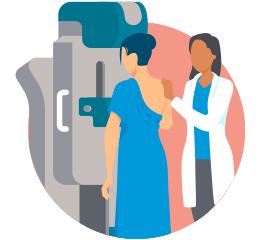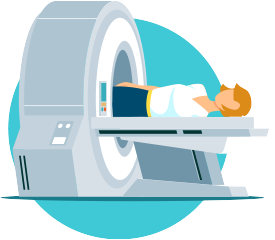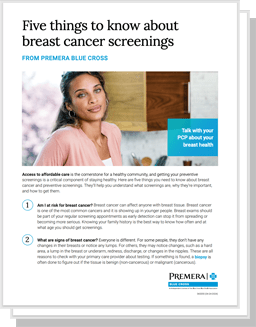Breast Cancer Screenings
A breast cancer screening is a test that looks for early signs of cancer in breast tissue. Finding cancer early can help make treatment more effective and less invasive.
Need to catch up on this screening? Contact your primary care provider to schedule a visit.
Who should get screened?

WOMEN WITH AVERAGE RISK
AGES 40-74
Many healthcare providers recommend a screening mammogram every two years.

WOMEN AT
Higher risk
If you have a family history of breast cancer or other risk factors, your doctor may recommend starting screenings earlier or having additional tests.
Types of breast cancer screenings

Mammogram:
This is a specialized low dose x-ray imaging technique to see inside the breasts. It helps find small signs of cancer before you feel any changes.
What happens during a mammogram screening?:
This is an imaging technique to see inside the breasts. It helps find small signs of cancer before you feel any changes.

Other tests:
Sometimes, your provider may also use ultrasound or MRI tests to take a closer look.
Additional tests:
Follow-up tests may be needed if anything out of the ordinary is found.
What do the results mean?

Normal results:
Nothing out of the ordinary was found. Continue with recommended screening exams.

Abnormal results:
Mammography can find various changes in the breast. These might include small calcium deposits, lumps, or other changes in the breast tissue. Calcium deposits can sometimes be an early sign of breast cancer or other issues. Lumps can be either non-cancerous (benign) or cancerous (malignant). Changes in breast tissue might mean there are abnormalities. Your provider will talk about any findings with you and discuss next steps.
How much will it cost?
Most health plans, including yours, cover breast cancer screenings at no extra cost when you visit an in-network provider. Check your benefits to see what is included.


Preventive versus diagnostic:
what’s the difference?
Preventive screenings are done when you have no symptoms but are of a certain age. They are always fully covered when you see an in-network healthcare provider.
Diagnostic mammograms are used when there are breast symptoms like a lump, nipple discharge, breast pain, or if a screening mammogram shows something unusual, and gives more detailed images to look closer at the area of concern.
- Important: Please discuss all diagnostic tests with your provider, as you may be required to pay a share of these costs. Also, verify that your provider’s imaging center of choice is in network to avoid additional costs.
Next steps

Schedule your screening:
If you’re due for a screening, book an appointment with your provider.

Stay informed:
Regular screenings can catch changes early and help you take charge of your health.
Establish care with a primary care provider
A primary care provider (PCP) who knows you well is vital to staying healthy. PCPs know your health history and can help guide you on your healthcare journey. If you don’t already have a PCP, you can find one by signing in to your account and using the Find Care tool.
The power of prevention
Early detection helps save lives. Prioritize your health by staying on top of your breast cancer screenings. Talk to your healthcare provider about how often and when to be screened. If you would like more detailed information about this covered screening, you can also download this 5 Things guide.

